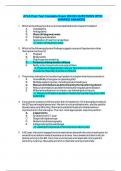Exam (elaborations)
ATLS 10th Edition Post Test Actual Questions with Verified Answers (2024 / 2025), 100% Guarantee Pass A+.
Course
Course ATLS 10th Edition
Institution
Course ATLS 10th Edition
ATLS 10th Edition Post Test Actual Questions with Verified Answers (2024 / 2025), 100% Guarantee Pass A+.ATLS 10th Edition Post Test Actual Questions with Verified Answers (2024 / 2025), 100% Guarantee Pass A+.ATLS 10th Edition Post Test Actual Questions with Verified Answers (2024 / 2025), 100% ...
[Show more]
Preview 4 out of 42 pages
Uploaded on
October 12, 2024
Number of pages
42
Written in
2024/2025
Type
Exam (elaborations)
Contains
Questions & answers
Institution
Course ATLS 10th Edition
Course
Course ATLS 10th Edition
$14.49
100% satisfaction guarantee
Immediately available after payment
Both online and in PDF
No strings attached
ATLS Post Test Complete Exam 2024|25 QUESTIONS WITH




